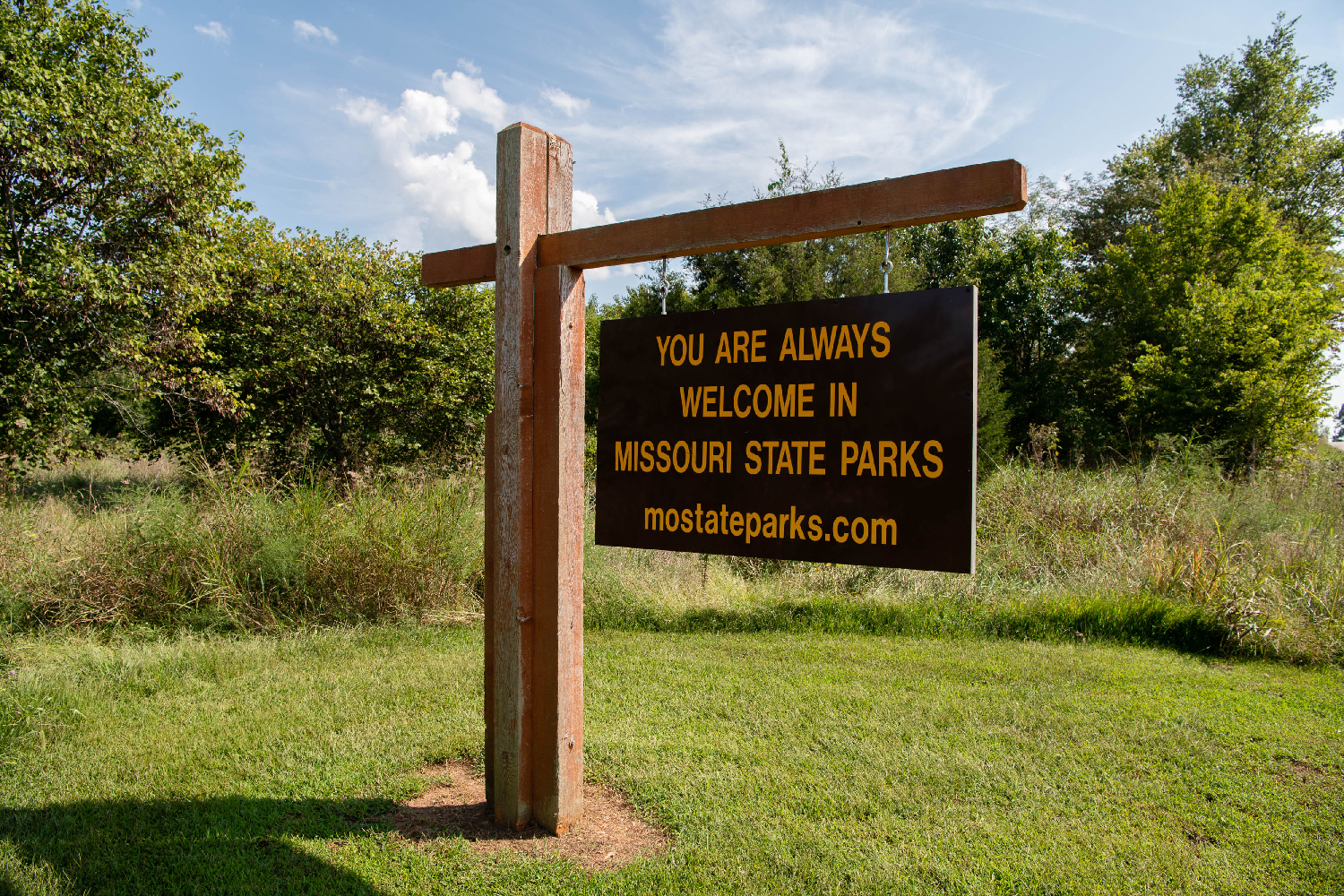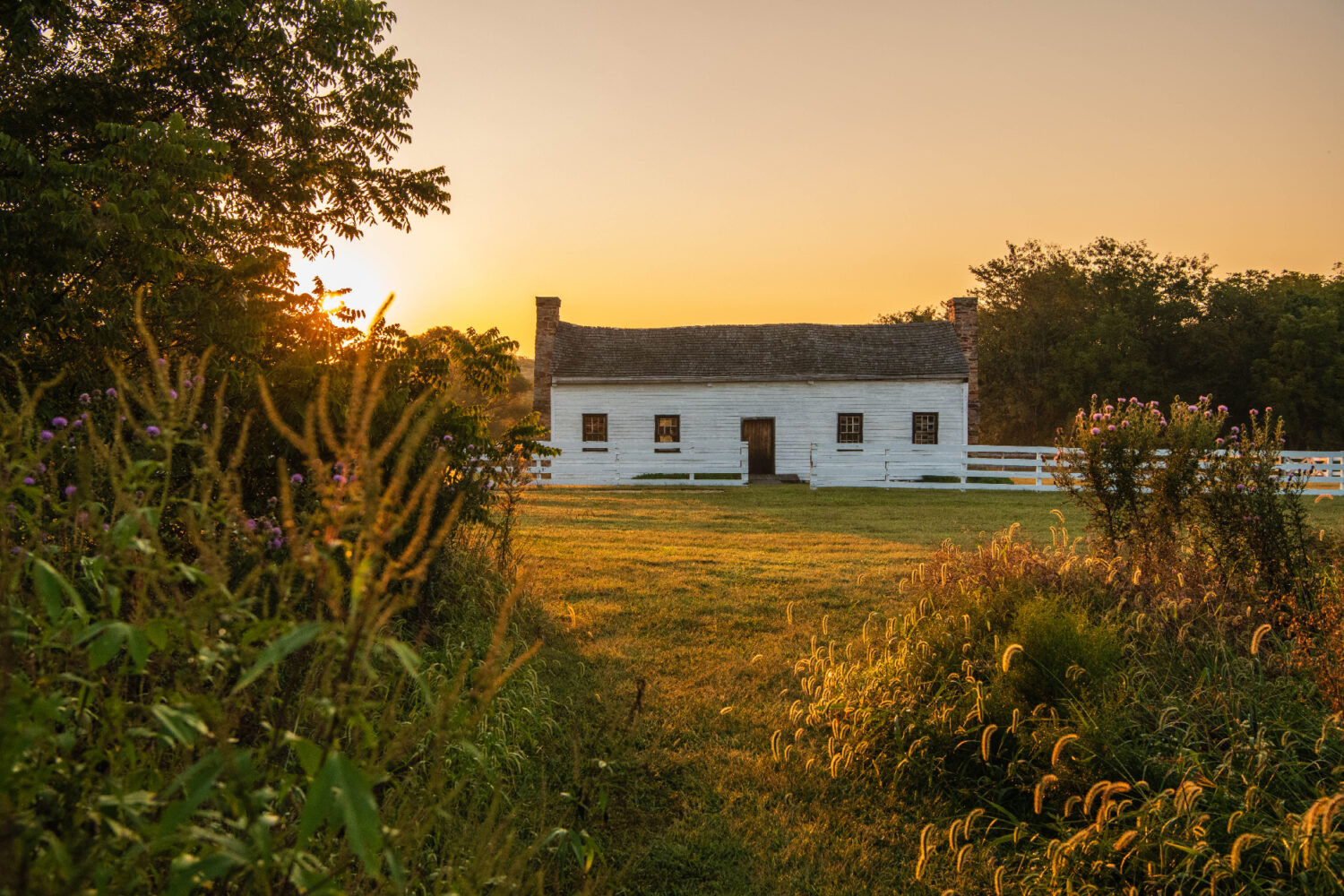An amazing early morning view from the interpretive trail at Nathan and Olive Boone Homestead State Historic Site showcases the historic homestead house. The Parks, Soils and Water Sales Tax helps fund tours at the site.
MoDNR photo by Ben Nickelson
Published by
on
Tall trees blowing in the wind, a gentle stream flowing alongside a trail, the sound of birds chirping, catching a glimpse of a shy deer grazing in the sun — all common sights and sounds at Missouri’s state parks and historic sites. These examples of the state’s natural and cultural resources help to highlight the mission of Missouri State Parks.
Missouri’s state parks offer a temporary escape from the hustle and bustle of cities, as well as a chance to reconnect with the outdoors, where citizens can explore the natural diversity throughout the state. Historically, Missouri’s land has been preserved so generations can enjoy the state’s rich beauty.
In order to preserve our parks, many organizations and individuals worked together to create a one tenth of 1% sales tax through a constitutional amendment. In 1984, Missouri voters became the first in the country to approve what is now known as the Parks, Soils and Water Sales Tax. Every 10 years voters have shown their support by reapproving the tax. In 2016, an overwhelming 80% of voters statewide voted to renew the sales tax for another ten years.
“Missouri State Parks does an incredible job with its upkeep, and the Katy Trail is smooth, shady, beautiful and easy to follow.”
– Michael Wardian, professional runner
“Growing up, Castlewood State Park was always my favorite, with all of its recreational areas and hiking trails,” said Mike Threlkeld of St. Louis. “While I love Castlewood, I’ve had the chance to hike, fish and camp in more than a dozen other parks. All are well maintained, easily accessible and free to the public. Many offer free services like guided hikes, interpretive programs and other outdoor activities for kids and adults alike.”
The sales tax helps to provide critical funding for the department’s core functions, including protecting our soil, improving water quality and managing the state park system. This consistent funding has helped Missouri State Parks maintain its current system, as well as provide upgrades and renovations while still protecting our natural, cultural and historic resources. This sales tax allows Missouri to be one of seven states that offer free access into state parks.

“The services that aren’t free — like tours, rentals and camping — are still reasonably priced,” Threlkeld said. “There’s something for everyone, young and old. If it’s outdoors, you can find a park to suit your favorite activity.”
Dick Wardian agrees. Dick is the father of professional runner, Michael Wardian. Michael ran from San Francisco, California, to Rehoboth Beach, Delaware, to raise money for World Vision, an organization whose mission is to provide clean and safe drinking water for families across the world. The elder Wardian was Michael’s “gofer” and crew member on the trip. While going through Missouri, everyone told Michael to run the Katy Trail. Although it was a slight detour, it didn’t disappoint.

“This linear park is an excellent way to traverse Missouri while moving slow enough to see and feel the change as one goes from fields and hamlets to river valley and former rail and river towns, with easy access from the trail to towns and cities via bike lanes and dedicated bike or pedestrian access on most bridges,” said Dick Wardian. “The fact that the trail provides frequent rest stops with benches, covered platforms, water, basic bike tools, air pumps, informational signs, maps and clean, functional restrooms is marvelous! Our time on the Katy Trail was restorative for Michael after the hard, dusty and often dangerous roads he had run from California.”
Michael Wardian echoed his dad, saying the Katy Trail was a beacon during his transcontinental run. He first heard about the park on social media, then he met a cyclist in Nevada who enthusiastically told him he absolutely must cross Missouri on the Katy Trail.
“Every single person I spoke to before I got to the Katy Trail gushed about it,” Michael Wardian said. “I really didn’t believe it was going to be as nice as it turned out to be. Missouri State Parks does an incredible job with its upkeep, and the Katy Trail is smooth, shady, beautiful and easy to follow.”
The professional marathon and ultra-marathon runner said he was blown away by the morning sunrises and also by how many people he saw using the park system around him.
“I loved getting off the roads and enjoying one of the most stunning states in the U.S. I hope to someday revisit the Katy Trail and I highly recommend people experience all Missouri has to offer,” he said.

Throughout the years, while other states have closed parks and charged entrance fees, Missouri’s continue to be open and free to all, while reaching record attendance levels in the last few years. The sales tax helps guarantee everyone has the chance to enjoy nature, outdoor recreation and history.
Missouri’s state parks and historic sites aren’t the only benefactor from the sales tax; soil and water conservation is included. They may seem like an odd coupling until you delve deeper into their commonalities. Both serve all of Missouri, encouraging use of their respective natural resources. Both protect those resources from overuse, damage or potential depletion; thereby, creating clear reasons for why dividing the tax makes sense.
The majority of the sales tax earmarked for soil and water conservation is used to assist agricultural landowners through voluntary programs developed by the Soil and Water Districts Commission and administered by the Missouri Department of Natural Resources’ Soil and Water Conservation Program in each of the 114 counties.
Since 1984, Missouri farmers have voluntarily implemented more than 255,000 structural and management conservation practices for crop, pasture, wood and hay lands.
Learn more about Missouri’s Parks, Soils and Water Sales Tax on the Missouri Department of Natural Resources’ website.





